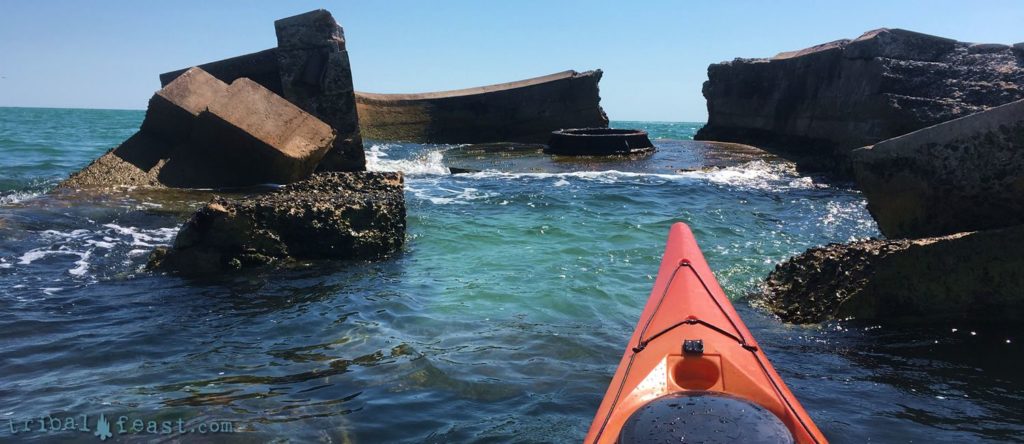What if I told you that you could launch a kayak from a Gulf Coast Florida beach and paddle out to have an adventure picnic on the ruins of a half-submerged Spanish-American fort? Cool, right?
But hang tight, because getting to the sunken fort (actually it’s just a battery from a much larger fort) can be challenging. To make the round trip safely, you will need some knowledge, a good amount of paddling ability, the right gear, and some careful planning. This should be considered a moderate to strenuous adventure, but if you are not able to make such a kayak trip, we’ll go over some great options for you as well.
For now, let’s start out with the general location of our objective.
Egmont Key is a small barrier island on the Gulf Coast of Florida just south of St Petersburg and North of Bradenton. Currently a designated National Wildlife Refuge and Florida State Park, the island has a long and fascinating military history due to its strategic location at the mouth of Tampa Bay. Because the island has so much to offer in history, nature, and beauty, it is a popular day trip destination for boaters and paddlers.
There is much to do and see on both Egmont Key and at nearby Fort Desoto. Although our focus is getting you safely to Battery Burchsted and one of the coolest adventure picnic experiences in Florida, it’s worth taking out a few minutes to talk about these other points of interest.
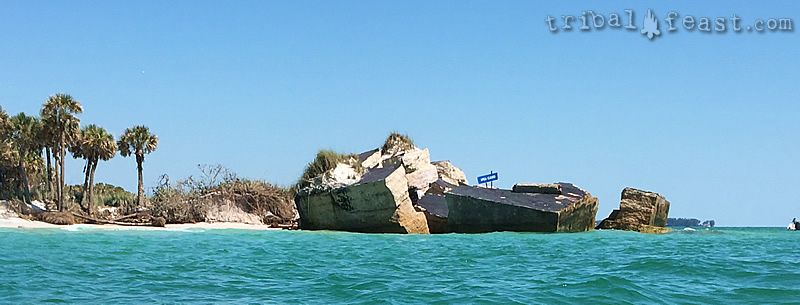
A Nature Lover’s Paradise
Established as a National Wildlife Refuge in 1974, Egmont Key has an abundance of wildlife and habitats. On the island, while walking through the palmettos and palms, you can encounter gopher tortoises, lizards, and birds of all types. Well-marked bird sanctuaries on both the northern and southern tips of the island offer nesting birds an undisturbed rookery and bird watchers with binoculars a premier birding experience.
The waters around the island have abundant sea life and while out on the water it is not uncommon to encounter dolphin, manatees, sea turtles, and rays. In and around the many ruins being reclaimed by the sea (we’ll talk more about this below) you can see large schools of baitfish, and occasionally larger gamefish like snook, snapper, and grouper.
The History of Egmont Key
If you are into military history, historical ruins, and old forts, Egmont Key and the surrounding area will keep you busy for days. The tiny island has served as a Seminole prison camp during the Third Seminole War, a Union naval base in the Civil War, and as a defensive fortification during the Spanish American War. Sadly, many of the historic structures on the island are slowly being claimed by the sea due to erosion and sea level rise.
A Place of Tragedy
Egmont Key served as an internment camp for Seminole Indians during the Third Seminole War (1855-1858), when native Floridians fought back against the Indian Removal Act of 1830. An untold number of Seminole Indians were imprisoned here in horrific conditions while awaiting relocation to the western U.S. via the infamous “Trail of Tears”. Many perished before making it off the island.
There is little physical trace of this era of the island’s past, however it is important to be aware of the role the island played in this dark chapter of American history.
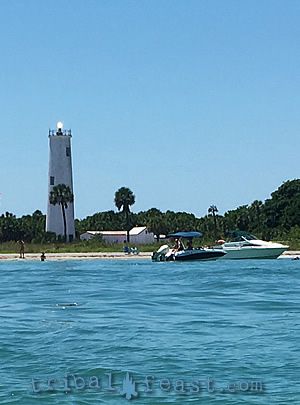 The Egmont Key Lighthouse
The Egmont Key Lighthouse

Constructed in 1858, the 87 foot tall lighthouse on the northern end of the island still helps to guide ships safely into Tampa Bay. During the Civil War, as the Union attempted to blockade Tampa Bay, the lighthouse was a key strategic asset for both sides. Over the course of the war, if fell under the control of both Union and Confederate forces.
Fort Dade
In 1898, at the outbreak of the Spanish-American War, a large defensive military complex was built on the island. The large fort consisted of a wide array of batteries, bunkers, posts, and dining halls, and there was even a power station and narrow gauge railroad to keep it all running smoothly.
To house the many troops defending Egmont Key and Tampa Bay, a small town was constructed on the island with red brick streets connecting the many homes, barracks, storehouses, gymnasiums, and other buildings.
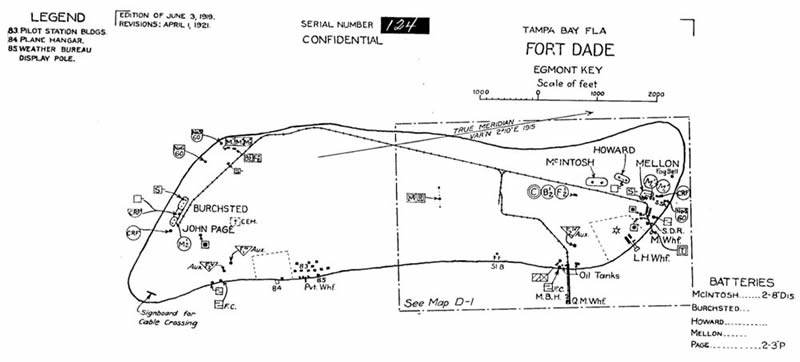
The fort remained active until 1923, when it was deactivated and eventually abandoned. You can read more about the history of Fort Dade here.
While time and the elements are slowly reclaiming the island, there is an impressive array of standing structures to explore, and with the exception of a few hazardous areas and the wildlife refuges, you are free to roam where your curiosity takes you.
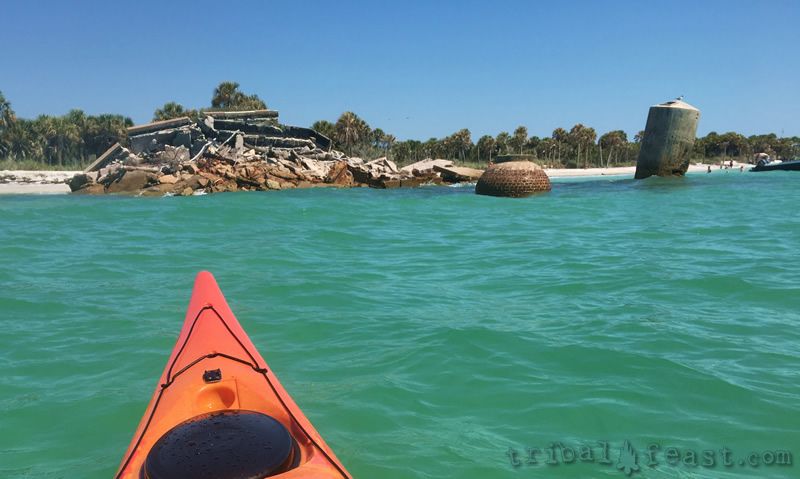
Between the many fortifications, the wildlife preserves, the island ghost town, and the beautiful beaches, you couldn’t possibly see everything in a day. Just keep in mind that this is a popular spot with boaters and vacationers. A beautiful day during the winter months can mean crowded beaches and congested boat traffic – not always the best scenario for a kayaker.
And this brings us to our prime objective: the sunken fort.
Battery Burchsted, A Unique Picnicking Experience
Part of Fort Dade, Battery Burchsted and the nearby Battery Page were defensive fortifications built on the south end of the island. Because of erosion and the ever-changing environment of a barrier island, these impressive fortifications are now out in the water a hundred yards or so from shore and are slowly being overtaken by the sea.
Much of Battery Burchsted is still above water and is visible from quite a long way off. As you paddle up to the ruins you can’t help but marvel at the impressiveness of the fortification. The bases of the gun turrets are badly damaged but easily discernible and you can pick out details from the original structure like stairs and window casings. Many of these details are beneath the surface of the usually clear water and are plainly visible from a kayak.
The above water portion of the ruins are substantial and there is plenty of space on which to pull up a few kayaks and have a picnic lunch. Cooking up a fun meal on the ruins of a sunken fort off a tropical beach is a truly awesome experience, however as noted above, it is an experience every boater in the area wants to have as well. If it is anything close to a nice day, you will not have it to yourself.
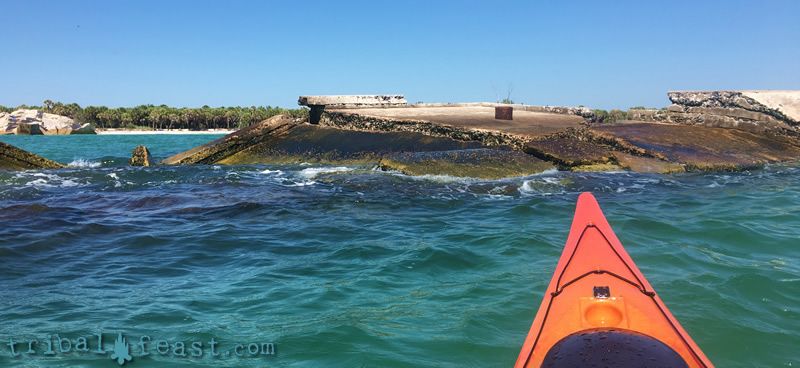
Paddling to the Island
To be clear, this is not a recommended trip for a novice paddler! Beyond the hour or so of paddling through strong currents and boat traffic to get to the main island, paddling safely around (and landing on) a concrete ruin that is being hit by waves takes an even higher degree of skill.
To make this trip, you should be comfortable paddling for an entire day, have a sound understanding of tides and weather, and have experience reading surf and currents.
Know When to Bail Out
You should also be able to recognize when conditions are worsening and have the judgement to turn around. Weather and tide reports should be considered a starting point for identifying safe conditions, Use your common sense and best judgement when out on the water.
Also, if you’ve made it to Battery Burchsted and you find the waves too dangerous to land, don’t take chances, Have your picnic lunch on the nearby beach instead.
Use an Appropriate Kayak
This is big water paddling! We’ll get into launch points in a bit, but regardless of where you launch from, a 14 foot kayak would be the absolute minimum length you would want to use for the crossing to Egmont.
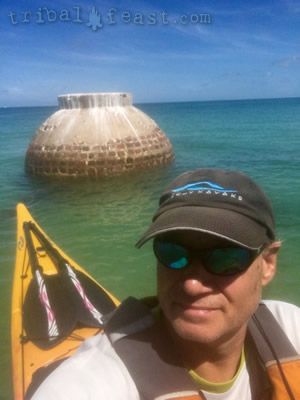
The ideal kayak for the journey would be a 16 to 17 foot sea kayak (also known as a touring kayak) with a spray skirt and appropriate rescue gear. A longer, faster Sit-On-Top kayak in the 14 to 16 foot range can also be used, but keep in mind that many of the modern fishing kayaks are built with gear storage and stability as the prime objective, not speed or maneuverability.
“Recreational” Sit-Inside kayaks may have the speed for this trip, but can be very unsafe in the bigger water unless you have a very good spray skirt and are very capable at self rescue. Yes, people do make the trip in recreational kayaks all the time, but it is neither wise nor safe.
I want to state clearly again that conditions out there can change rapidly – make sure you have a kayak that can handle those conditions and you have the skills and strength to handle your kayak.
Use the proper safety gear
Wear your PFD at ALL times while making the crossing. Make sure you have a signal device on you and you have the appropriate safety and self rescue gear for your kayak, which might include a spray skirt, paddle float, and spare paddle. A VHF marine radio and waterproof flares are also a good idea if you have them.
Check the Tides
This is no joke. The amount of water that comes screaming out of Tampa Bay on a high outgoing tide is considerable – at least from a Florida perspective. Unless you are used to paddling in strong tides or used to open water navigation in bigger currents, pick a day with mild tides and plan your trip so that you make each crossing (there and back) as close to the slack tide as possible.
Check the Weather
Obviously you don’t want to go kayaking in a hurricane, but even a mild onshore wind can make this trip not fun. When even a mild wind blows against a hard current it can make for some extreme conditions in small isolated patches. Pick a day with light winds, but know that light winds don’t always mean light waves.
It is also worth noting that no matter which side of the bay you launch from, if there is a strong outgoing tide and a moderate offshore wind, you can easily get blown out to sea.
Use the Buddy System
Because you will be paddling for most of the day, it is always best to go with a friend or a small, experienced group. This is one adventure picnic where there is safety in numbers – as long as everyone has the strength, skill, and experience to be able to make the journey on their own.
Landing a Kayak on the Battery
Landing a kayak on the battery can be tricky at times due to waves and wind direction. Keep in mind the many dangers including getting an arm or leg caught in the rocks and the ever present danger of head injury whenever you kayak around hard submerged structures. Circle the battery a few times to determine the safest place to land and launch from.
Keep an eye on the sea while you are on the battery. Conditions can change rapidly and you don’t want to realize that launching your kayak back out into the gulf will not be safe.
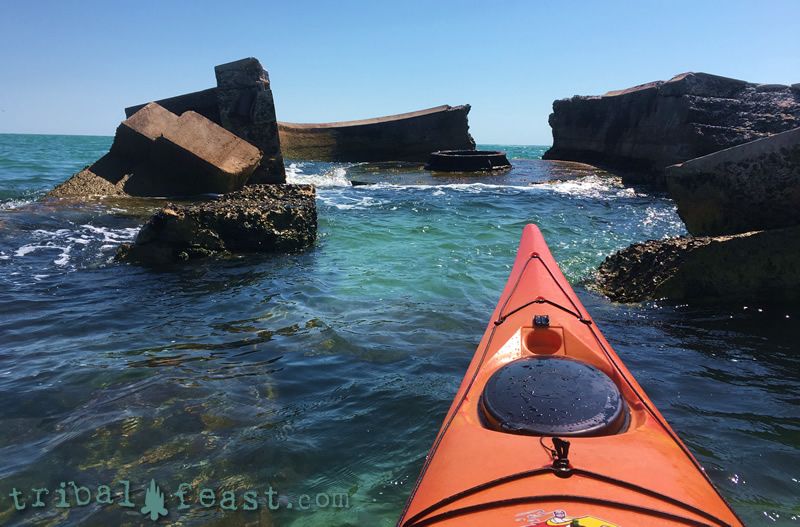
Avoiding the Crowds
The formula here is simple: nice day + holiday = crowds and boat traffic. For kayaking, if at all possible, you ideally want to go during the week when everyone is at work. Also, pick an overcast day when the weather is stable and not too windy. What you will give up in sunshine, you will make up for in solitude.
Several times I’ve paddled out to Egmont with the intention of firing up my camp stove on Battery Burchsted but ended up on the nearby beach just because of the amount of boats moored up to the ruins. There were so many people on the battery that the less-crowded beach was a more peaceful alternative.
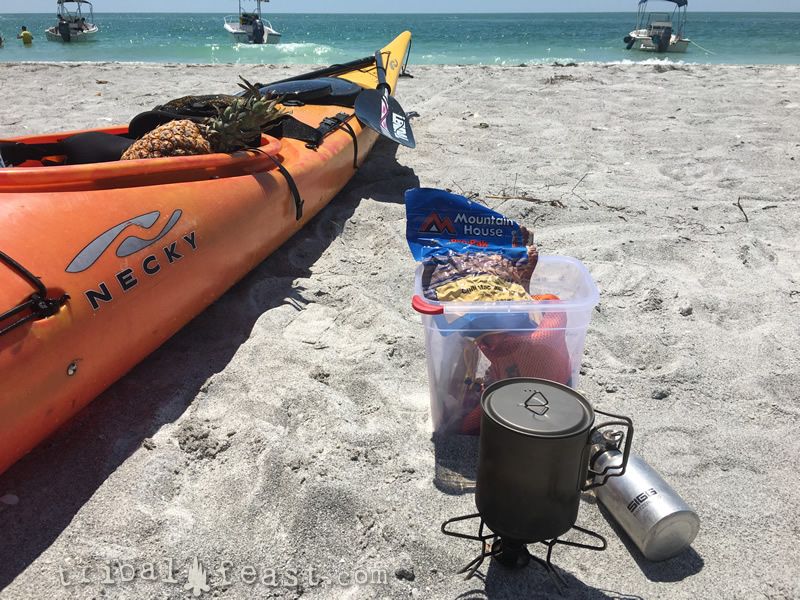
What to Bring
Assuming that you are going to try to land on Battery Burchsted for a picnic, there a few items that can make your time either more comfortable or fun.
Good Shoes
You are going to be walking around a concrete and coquina ruin with chunks of rusty iron sticking out all over the place. Wear good, protective shoes and have them on before you try to land on the battery.
Snorkel and Mask
If it is a calm day, snorkeling around Battery Burchsted and other ruins off Egmont Key can be fantastic. If If you have a snorkel and mask, bring it with you!
Beach Towel
The best thing to sit on while picnicking on the battery is simply a beach towel. There is not a lot of level ground for chairs, and the little bit of padding the towel provides will be appreciated. Also, you can use it as a towel!
Kayak Cart
This is one piece of gear I always appreciate having with me in the kayak on paddling adventures like this. Beyond coming in handy for launching your kayak and returning to your car at the end of the day, a kayak cart can make exploring the island a lot easier. Having the ability to easily roll your kayak up to a safe location so you can go off exploring by foot is so freeing. Don’t forget to bring a long cable lock so you can make sure it stays put once you find an out-of-the-way safe place to stow your kayak.
I have to give a plug for my favorite kayak cart, the C-Tug. Why this cart is ideal is that it breaks down small enough to fit into very small hatches and the wheels roll easily on both sand and hard ground. Also, the tires don’t go flat! You can get more info and check the current price on Amazon.
Launching from Fort Desoto
The ideal place to launch from if you are paddling to Egmont Key is Fort Desoto Park. Not only is the paddle a bit easier than launching from Anna Maria (see below), but there is plenty to do and see at Fort Desoto, including, you guessed it, another fort!
Camping
Another great advantage to launching from Fort Desoto is that you can camp there! Plan a three day weekend (or midweek trip) and spend the middle day paddling out to Egmont Key and Battery Burchsted.
Fort Desoto Park is part of the Pinellas County Parks and Preserves system and you can get more information and make camping reservations on their website.
Parking
If you are just going for the day, my personal favorite place to launch is the East Beach picnic area on the east side of the park. Turn left when the Pinellas Bayway South dead ends into Anderson Blvd and you will see the picnic pavilions on your right.
As mentioned above, a kayak cart will make the arduous journey of getting your kayak from you car to the water much easier.
Paddling
The hardest part of the paddle from East Beach to Egmont is crossing the shipping channel. If there are any large vessels in the channel, stay away and wait it out! Large ships cannot stop and they push huge wakes, some large enough for you to surf your kayak on even hundreds of yards away. Wait until the coast is clear and then cross the channel at a perpendicular angle at a confident clip. Only stop when you are at the other side.
The currents are generally not too bad between Fort Desoto and Egmont Key, but on a strong outgoing tide, you may find yourself getting washed out to sea. Understanding ferrying techniques while paddling across currents and using multiple landmarks (following a transit) in your navigation can ensure you end up where you want to go.
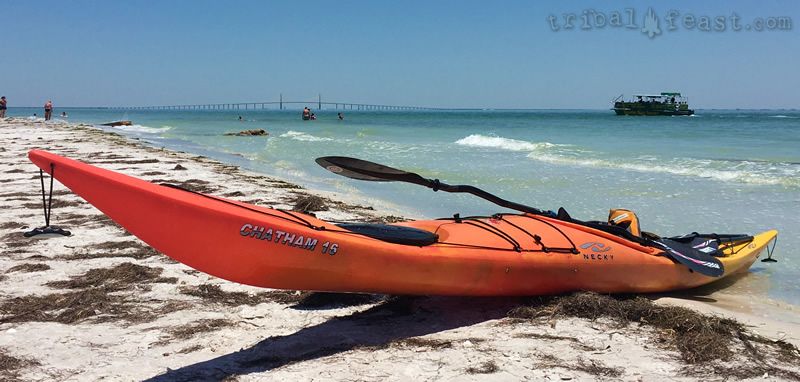
Launching from Anna Maria
The paddle from Anna Maria Island to Egmont Key looks pretty mild (and at times it is) but it can be an incredibly exhausting and possibly dangerous paddle if the conditions are not ideal and you lack the strength and experience for the wind and current. If, however, you are well prepared, and are paddling on a calm day with mild tides, the paddle from Anna Maria to Egmont can be delightful.
Passage Key National Wildlife Refuge
In between Anna Maria and Egmont Key is a tiny island and large sandbar called Passage Key. Locally this is known as “Naked Island” and if you paddle close enough on a day when lots of boats are there, you will soon see exactly why.
The island used to be a substantial plot of solid earth and served as a rookery to a variety of bird life, but erosion and storms have taken their toll and the last time I was near the island it didn’t appear to be much more than just a sandbar. The birds were gone and the boaters had moved in.
You can actually see a lot of wildlife here by kayak, however, as the large sand flat around Passage Key is a popular cruising spot for manatees, rays, dolphins, sharks, and sea turtles. In the spring it is not uncommon to see large groups of randy male manatees following a beleaguered female.
The calmer water around Passage Key also makes for a nice break from the two distinct sections of current, Passage Key Inlet and the Southwest Channel, that you must cross on your paddle to and from Egmont Key.
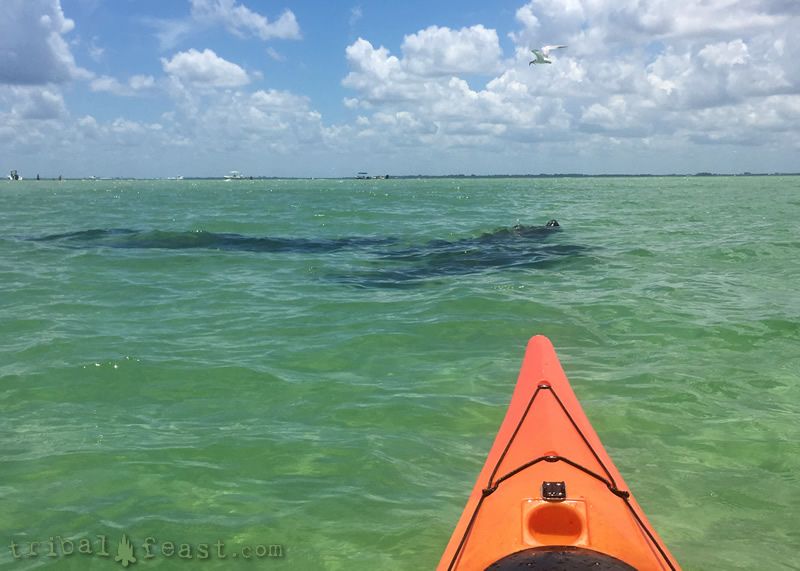
Parking
The best place to launch from is Bayfront Park off North Bay Blvd. Parking here is free, but it is also “first come, first served” and this is a very popular park. Get here early! If it’s the weekend, plan on unloading your kayak to launch at first light and you shouldn’t have a problem getting a spot.
The good news is that it isn’t very far from your car to the water and I’ve hoofed it with my kayak on my shoulder on quite a few occasions. Again, a kayak cart makes paddling life so much easier.
Paddling
What makes this paddle so difficult is the chop in the two main channels and the speed of the tidal currents. These currents can get particularly dangerous during a strong outgoing tide with an offshore wind and, in making the crossing, you need to travel across them.
Always check the tides before heading out in a kayak in coastal waters, but in the case of this crossing, try to avoid picking days near the full or new moon when tidal flow is the strongest. The current can be absolutely ripping on an even moderate tidal flow, so it’s best to pick your day carefully and time your paddle so that you make the crossing, both coming and going, at or near slack tide.
If for some reason you do have to paddle across a strong tidal flow, use the following technique: Rather than making your destination (near your car) the point you actually want to arrive at, pick another point far upcurrent – and by far I mean as much as a mile or more if the current is ripping. While still in calm water, paddle parallel to the heavy current headed against it in the milder current. Once you are directly across the faster current from your new upstream point, turn slightly into the current and ferry yourself across. You may be paddling forward, but you will be moving backwards (downcurrent) quickly, having absolutely no chance whatsoever in making your new destination. Don’t let this phase you. Focus instead on your original destination which now may be reachable if you continue to ferry yourself across.
The worst case scenario here will be that either you made it across too far upcurrent – an easy fix since you just drift down with the tide – or you realize that you are going to still completely miss your goal and get blown out to sea. In this case, retreat back to calmer water and repeat the process above picking another point even farther upcurrent. In the end you may be tired from all the extra paddling, but you won’t be as tired as you would be had you tried to fight the current in a panic and got washed out to sea.
I’ve done a lot of paddling and kayak touring and have also done a lot of dumb things. One of those was paddling back to Anna Maria one evening during a strong outgoing tide after having paddled completely across Tampa Bay and back. But I had all the proper safety gear and employed the technique above, knowing full well I couldn’t fight the current. It was a brutal paddle and I was exhausted in the end, but I was never in danger and felt in control of the situation at all times. I was also adequately prepared should I that situation changed for the worst.
The TL;DR: Know what you are doing, have good gear, and never take unnecessary chances with your safety or well being. If you feel like skimping on any one of those things, or taking this paddle trip after only reading the TL;DR, this adventure is not for you.
What if I Can’t Make the Paddle But Still Want to Go?
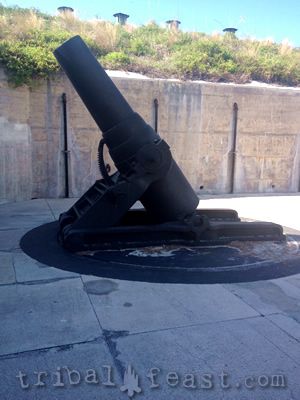
If making the kayak trip is out for you, the best way to see Egmont Key and even Battery Burchsted is by boat. You can rent a boat, but this is one time spending extra money for a capable guide is the smart thing to do. If you can’t afford to hire a guide on your own, find or make some friends and split the cost.
Alternatively, you can take a ferry to Egmont Key from the Fort Desoto side. This is a very inexpensive way to get out to the island and you may see quite a bit of sea life on the way. I’ve never taken the ferry, so I can’t speak to the experience personally, however just spending time on Egmont Key is worth every bit of the low price of the ferry. You can get more information on the ferry here.
Final Thoughts
Egmont Key is a magical place filled with nature, history, culture, and tragedy. Getting there by kayak, under your own power, makes the experience far more intimate and meaningful. Although I no longer reside in Florida, my experiences paddling out to Egmont and exploring all the ruins are very special to me. And most special of all were those very few times that I had Battery Burchsted all to myself. Sipping a hot cup of coffee with a belly full of food, staring out at the shimmering Gulf of Mexico, as you sit on a sunken fort surrounded by water is simply sublime. I highly recommend it.

